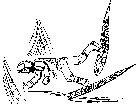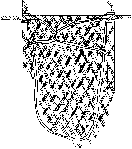Snowshoes
|
Snowshoes have been a part of the traditional culture in interior
Alaska for more years than we can trace.
The design of snowshoes has varied from location to location, controlled mostly by the needs, conditions, and materials at hand. |
||
|
|||
|
|
Size and ShapeHow big should snowshoes be? If they are too wide, the person will walk bowlegged. If they are too narrow, they won’t have enough surface area to support the traveler. If they are too short, they will not have enough surface area to support the person. Traveling in soft snow will be very difficult. If they are too long, they will be too heavy, and difficult to use in the brush. If they don’t have enough turn-up in the front, they dive into the snow, and cause the traveler to constantly fall. If they have too much turn up, they won’t provide enough area on a harder surface to support the traveler. |
||
|
|
|
||

|
PSIThe pressure that snowshoes exert on the snow can be described in pounds per square inch (psi). A heavier person will sink deeper on the same pair of snowshoes than a lighter person because the pounds per square inch of snowshoe surface is greater. Both a lighter and a heavier person sink deeper in powder snow because the strength of the snow is less than the strength of packed snow. The optimum size of snowshoes depends on the traveler, snow conditions, and use. If the traveler is fairly light or usually travels on hard-packed or drifted snow, small shoes will be enough. Once the traveler sinks deeper than his knees, traveling becomes very difficult. In powder snow, I have never found a pair of snowshoes that I thought were too big except in a few experiences fighting through brush. Oldtimers purposely used smaller snowshoes to break trail a good trail for dogs or other people following behind. When they ran down a moose, they often used very large snowshoes (six feet) to stay on top of the snow and conserve their energy. The front of some snowshoes dive into the snow, tripping the traveler. To prevent this:
These three features work together to keep the front of the snowshoes from diving. The Tail Some trail model snowshoes have a long tail. It serves an important purpose. The tail keeps the snowshoe pointing forward, like the keel on a canoe or tail on a kite. Without the tail, the snowshoe would swing from side to side, particularly in the brush, getting hung up, slowing and frustrating the traveler. Mesh The mesh underfoot obviously needs to be bigger and stronger than that in the front and back. Powder snow demands mesh in the front and back that is smaller and more tightly woven to provide adequate surface area. Wetter or coarser snow demands mesh that is thicker and more durable against abrasion. |
||
|
|
MaterialsFrames A well-chosen birch tree is tougher than all commercial woods sawn from a tree. Not every birch tree is adequate. Oldtimers spent days and months looking for the right tree with the proper grain that was flexible, durable and with no knots. Once they found the tree they were looking for, they split the snowshoe frame from the tree. This left the strength of the natural grain intact. Sometimes hot water or steam were used to bend the frame. Great care was used to avoid overheating. Heating and steaming weaken the wood. Commercial snowshoe frames are made from hickory or ash. The wood is sawn from planks rather than split, so the grain of the frames are greatly weakened. All first growth ash and hickory are gone from the United States as well as most of the second growth. The hickory and ash harvested now are from small, third-growth trees. Manufacturers have experimented with aluminum alloys. They are very light and strong. It doesn’t take much imagination to know what happens in overflow. Webbing For webbing, oldtimers used the skin from the belly of a spring moose. This is the strongest and toughest skin available. Caribou is a close second. There is a real art to making the rawhide as it takes two people working well together… a true test of a marriage or friendship! We used to skin moose very carefully. Nowadays, it is hard to find a good skin to work on. Untreated rawhide stretches when it is wet. Unfortunately, dogs like to eat rawhide and more than a few travelers have cursed their dogs for eating their snowshoes. Weaving the webbing to snowshoes in a way that is appropriate for local snow conditions is an art. Bindings Commercial bindings available today are functional, but the bindings on the old time snowshoes were light and could be put on or removed in seconds without using hands. Manila rope treated with linseed or vegetable oil works best for Native-style bindings because it is quiet and doesn’t stretch like synthetics. Rawhide stretches too much when wet. Few things are more miserable than snowshoe bindings that don’t work properly. There are some good quality modern bindings, but they are very expensive. Complex buckles and straps make travel on thin ice very dangerous. Traditional Native bindings come off with a twist of the foot. Noise Oiling snowshoes reduces noise when hunting. The friction of wood to wood, or rawhide to wood produces enough noise to alert animals, particularly in very cold weather. The sound of snow being compressed is loud enough in cold weather. Creaking snowshoes make matters much worse. Care Linseed oil discourages animals from eating the snowshoe webbing. Snowshoes are usually kept outside in a cool dry place, above the reach of animals. While birch has great strength, it tends to rot easily, and oil helps prevent this. As the best snowshoes are very light, the traveler must walk carefully to avoid breaking the frames. |
||
|
|
Activities
|
||

|
Student Response
|
||

|
Math
|

 Basic
Idea
Basic
Idea Two
Types
Two
Types Balance
Balance

